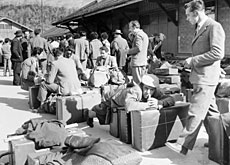Italians leave their mark on Switzerland

There are more than 300,000 Italians in Switzerland, officially making them the largest expatriate community in the country.
Although they are acknowledged to have had a significant influence on Swiss economic, social and cultural life, they are not yet fully integrated.
“Switzerland would not have achieved its present economic position without the contribution of the Italian labour force,” said Claudio Micheloni, the Italian-born general secretary of the Forum for the Integration of Migrants.
Italians first immigrated to Switzerland on a large scale between 1950 and 1970, mainly working the construction, engineering and catering industries.
They now number 312,000 – the largest foreign community in Switzerland, according to official statistics for 2003. This puts them ahead of the Serbia and Montenegro community (213,900).
However, the road to acceptance in Switzerland has not always been an easy one.
In the early days, Italian workers were not allowed to bring their families with them. Many lived in run-down accommodation in Italian “ghettos”.
This, coupled with the fact that they didn’t know the language, meant that they had little contact with the local population. Legal restrictions prevented them from changing jobs and limited their access to social security entitlements.
“In those years there was no process for achieving social integration and no intention of promoting it,” explained Micheloni. “Immigrants came to Switzerland simply to work, believing they would return home after a few years.”
Change
The situation began to change in the second half of the 1960s, when legal protection for migrant workers was improved and their families were allowed to join them.
But Switzerland was totally unprepared to meet the educational and social challenges posed by these new arrivals.
Italian voluntary organisations – formed mainly to provide social assistance – stepped in and played a vital role. They not only liaised with the local authorities over immigrants’ rights, but also organised language courses and educational support, as well as leisure activities for the community.
Some Swiss were at first reluctant to accept the Italians. “This is a constant factor: every new group of migrants awakens fears and prejudices,” said Micheloni.
But the migrants gradually managed to win acceptance, thanks to the major contribution they made the country’s economy, their warmth and cheerfulness and their efforts to fit in.
Italian cuisine has also been enthusiastically embraced by many Swiss families across the country.
Integration
But there are still some integration problems – especially for first-generation immigrants who, on reaching retirement age, decide to remain in Switzerland so they can be close to their children.
“It is apparent that these people are not so well integrated as we thought,” said Micheloni.
The younger generation, on the other hand, were born and brought up in Switzerland, speak the country’s national languages and have embraced Swiss habits and customs.
But they do not feel fully accepted by the Swiss, especially as it remains very difficult to gain Swiss citizenship.
Last September voters threw out proposals to grant automatic citizenship to third-generation foreigners and ease naturalisation restrictions on the second generation.
This means that the community cannot take part in the political life of the country. Only a handful of cantons grant voting rights to foreign nationals.
“It is only when immigrants obtain political rights that will we be able to say that they are successfully integrated,” concludes Micheloni.
swissinfo, Anna Passera
312,000 Italians were resident in Switzerland in 2003.
Figures for 2002 show that the largest Italian communities are from northern Italy (38.4 per cent) and the south, Sicily and Sardinia (51.6%).
There are large concentrations of Italian nationals in Zurich (22.7%), Basel (14.4%) and Lausanne (11.3%).
The mass exodus of Italian workers started after 1870 when they went to work on the Gotthard and Simplon railway tunnels.
Immigration to Switzerland reached its height between 1950 and 1970, when Italians became the country’s largest foreign community.
From the late 1970s, the world oil crisis and changes in the labour market led to a steady decline in the number of new immigrants.

In compliance with the JTI standards
More: SWI swissinfo.ch certified by the Journalism Trust Initiative










You can find an overview of ongoing debates with our journalists here . Please join us!
If you want to start a conversation about a topic raised in this article or want to report factual errors, email us at english@swissinfo.ch.